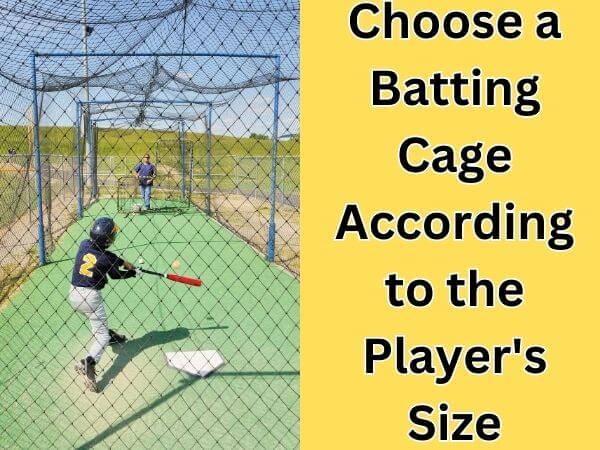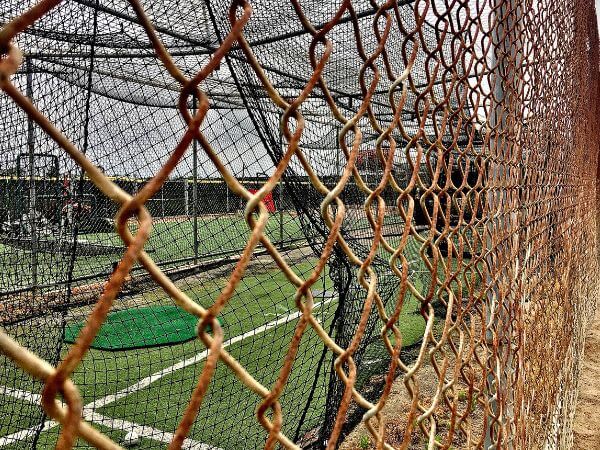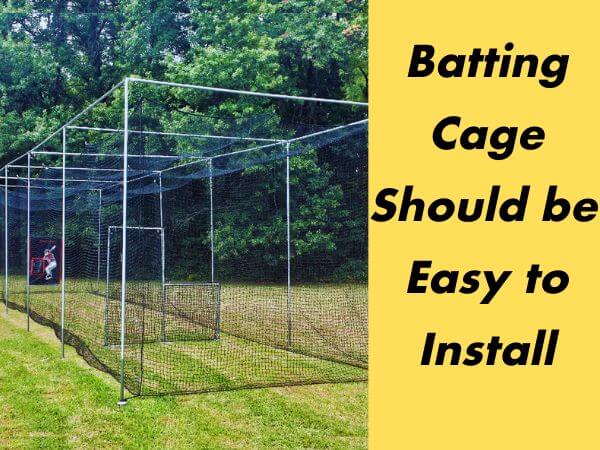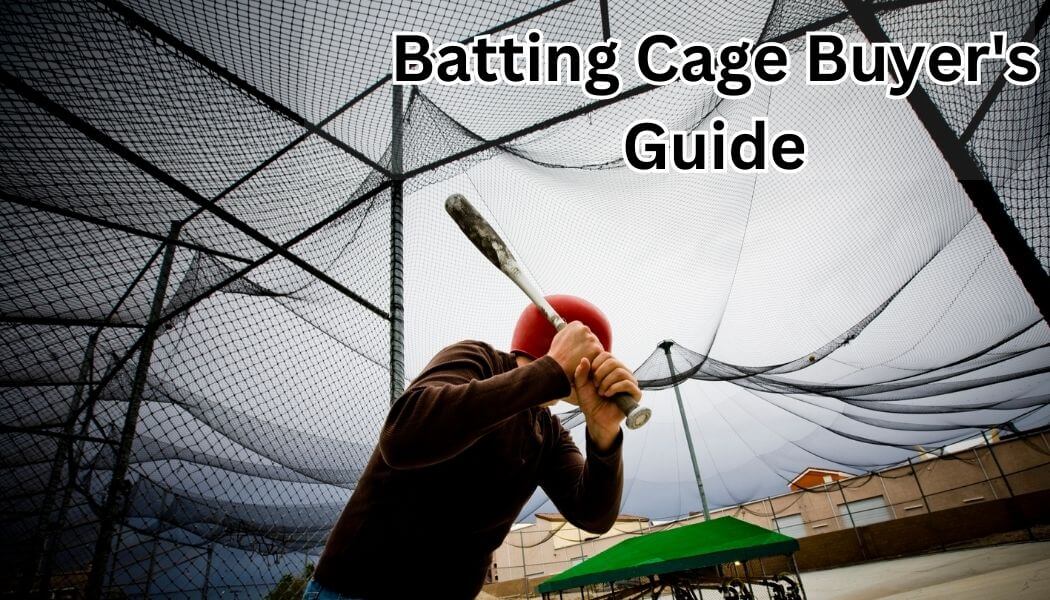A batting cage is an integral part of any serious baseball or softball player. Not only serious, those who are trying to break into this game, but they also need batting cages for practice.
But selecting a perfect batting cage is not that easy. Therefore, I prepared this batting cage buying guide.
I will cover the backyard batting cage with a professional-level batting cage so that you can pick one according to your need.
Types of Batting Cages
There are numerous options available when picking a batting cage. Different batting cages have different advantages and disadvantages. Some of the most common varieties of batting cages include:
1. Indoor Batting Cages: Indoor cages are typically more compact than their outside counterparts. Since they don’t have to survive severe weather, they can be made from less heavy materials.
2. Outdoor Batting Cages: The sturdy construction of these cages makes them ideal for usage in the great outdoors. For usage on wet days, rain coverings or tarps are included with some models.
3. Portable Batting Cages: If space is an issue, then portable batting cages would be your best choice. Their lightweight design makes them easy to move around and set up anywhere you need.
4. Professional Batting Cages: Designed for professional athletes or baseball teams who require top-of-the-line equipment, these high-end cages often come with advanced features such as pitching machines or ball feeders.
No matter what type of batting cage you choose, always considers its durability, size, and portability before making your final decision!
What Size Batting Cage Should I Get?
One of the first things you should consider is where you will be placing the cage. It’s important to measure the space to ensure that your chosen size will fit comfortably in that area.
Another factor to consider when determining what size batting cage you need is who will be using it. If you’re purchasing a batting cage for personal use, such as for your backyard or garage, then a smaller size may suffice.

Batting Cage Length Based on Age and Skill
For younger players or beginners, a shorter cage (around 30 feet) may be suitable as they are still developing their hitting technique.
For older or more advanced players, a longer cage (up to 70 feet) can provide more space for full swings and hitting drills. It’s also important to take into account the size of your backyard or practice area when deciding on length.
Another factor that can affect batting cage length is the type of pitching machine being used. If you have a higher-speed machine, you may want a longer cage to accommodate faster pitches.
Batting cages come in various sizes to suit different needs.
The length of the cage is important for measuring a batter’s performance. The ideal length is 70 feet, providing enough space between the pitcher and the batter, improving accuracy in tracking ball velocity.
If you have a small yard, there are shorter options available. Cages as short as 30 feet can still be beneficial for practice.
Here are some recommended lengths based on skill levels:
- Youth: 30 to 40 feet
- Intermediate: 50 to 60 feet
- College/Pro: 60 to 70 feet
If you prefer a shorter cage, that’s okay. While a regulation-sized cage offers a realistic practice environment, not everyone has enough space for a 70-foot cage. Shorter cages are space and cost-effective, and they can even help improve a batter’s reaction time.
With a shorter distance between the pitcher and the batter, the batter needs to react more quickly. This improvement will translate well to a regulation setting, as the batter can use their advanced skills to react faster to pitches. A shorter cage can also enhance a batter’s accuracy by requiring quick actions and precise swings to make contact with the ball.
How to Pick Batting Cage Width
Most batting cages are between 12 and 14 feet wide. A 12-foot-wide tunnel is enough for young players who are still learning. But a 14-foot-wide tunnel will help bigger and more experienced players.
The player’s length can also affect the width. If you or your batter have longer arms, you might want to think about a bigger cage.
If you have limited room or want to put the cage inside, you may need a narrower width.
The type of pitching machine or practice tools you plan to use with the cage is another thing that might affect your choice. Some machines need more space than others, so check the specifications of each one before making your final choice.
Selecting the Right Batting Cage Height
The height of your batting cage will depend on several factors, including the skill level of the players and the space available.
A 12-foot high batting cage is usually enough for most players. Just like longer cages allow better tracking of ball velocity, a greater height is beneficial too. If 12 feet is too tall for you, an 8-foot-high frame will work well. It’s important to consider the frame height based on the netting you plan to use.
You need to ensure there is extra room for the netting to sag on the ground, about one foot of overflow. This helps to keep the balls contained within the cage as they fly around.
For younger or less experienced players, a lower ceiling height may be appropriate as it reduces the risk of high-fly balls hitting an overhead structure. However, more advanced players may require a higher ceiling to allow them to hit balls with greater trajectory.
When selecting your batting cage height, consider not only the physical dimensions but also any local regulations that may dictate minimum heights for safety reasons.
How to Pick the Right Batting Cage Net
Netting Material and Durability
You need something sturdy that won’t break with the repeated pounding of baseballs. Nylon and polyethylene (PE) are the go-to fabrics for batting cage netting.
In comparison to nylon, polyethylene is less expensive yet may not last as long. Nylon is more expensive but stands up better to wear and tear thanks to its increased strength.
Think about the thickness of the netting in addition to the material. The durability of a net increases with its thickness, but it may become less transparent as a result. There is a trade-off between durability and ventilation in a cage, so choosing the right mesh size is important.
HDPE Vs Nylong Batting Cage Which One to Choose and When?

Here’s a deeper dive into the distinction between HDPE and Nylon nets, and why you’d want to make that distinction when deciding between indoor and outdoor use.
Nylon nets are frequently used in indoor batting cages. Due to its high strength and durability, Nylon is well-suited for indoor use under intense conditions. Its high breaking strength makes it resistant to wear and tear, guaranteeing reliable service throughout time.
Therefore, Nylon nets are a solid option for a batting cage that will be used frequently and intensively in an indoor practice session.
However, HDPE nets are versatile enough to be utilized in either indoor or outdoor batting cages. HDPE is a long-lasting substance that doesn’t get wet and stays dry. Because of this, you can use it outside because it won’t rot, shrink, or change color when exposed to water.
Also, HDPE nets can have UV filters built into their fibers, which protect them from sun damage and make them more resistant to weather.
HDPE nets are suitable for both indoor and outdoor use, while Nylon nets are more suited to inside settings due to their greater strength and durability.
Because of their resistance to moisture and UV protection, they are a more environmentally friendly choice for use in outdoor batting cages.
Whether you need a net for indoor or outdoor use, how often, and how long it needs to last all factor into whether HDPE or Nylon is the better option.
Frame Construction
The frame is essential for player protection since it gives the netting structure and support during training.
Galvanized steel is a popular choice for constructing batting cage frameworks. Because of its high resistance to rust and corrosion, this steel is great for outdoor applications. Due to their low weight and high durability, aluminum frames are also rising in popularity.
The wall thickness of the tubing used to build the frame should also be taken into account. You can expect more strength and longevity from thicker tubes. Thicker tubing may increase the total weight of the building, though.
Some batting cages’ frames connect to one another for simple assembly, while others call either bolts or screws. It’s crucial to pick a frame that you and your team won’t need outside aid putting together.
Spending some extra time hunting around for a batting cage with a solid structure will pay you in the long run.
Net Styles
There are four common types of net twine:
#21 Netting: Suitable for light home use or young players learning the ropes. It has a thin net and small mesh diameter, lasting around 3-4 years.
#30 Netting: Tougher than #21 netting, with a larger mesh diameter to withstand harder hits. Recommended for Little League players, it provides greater durability and lasts about 4-5 years.
#36 Netting: A middle-ground option for most ages and player levels, often used by high school players. It is tough, has a large mesh diameter, and survives most weather conditions for approximately 4-5 years.
#42 Netting: The strongest and most durable option, suitable for any weather conditions and hard hitters. It has a large mesh diameter and a lifespan of 5+ years.
Ease of Installation and Portability

The best batting cages may be assembled quickly and with minimal effort, and without the need for expensive or specialized tools. It should also be simple to set up and break down for storage.
A collapsible frame is one convenient feature that speeds up the setup process. When not in use, the cage can be collapsed into a more manageable size. Some cages also include simple instructions and the required hardware.
If you want to use your batting cage in multiple places, portability should be a top priority. Look for frames that aren’t too heavy to move about the backyard, park, school field, or even indoors if the weather turns bad.
Whether or not the netting can be detached from the frame also contributes to its portability. The ability to separate the netting from the poles reduces the overall size and weight of the batting cage, making it easier to move or store.
For the sake of convenience and quality practice time for players of all skill levels, choose a portable and simple-to-install baseball batting cage.
Additional Features and Accessories
In addition to the basic parts, a batting cage has a number of extra features and tools that can help you improve your practice. One famous accessory is the pitching machine, which makes it possible to throw pitches at different speeds and in different ways that are always accurate.
A turf or matting system is also helpful because it gives a level area for hitting and fielding drills. This can also help protect the batting cage net from wear and tear. You can also get a pitching mound for pitchers.
If you want to know about Pitching mounds read my detailed article on Pitching Mound Dimensions.
Some other helpful accessories are ball carts or buckets that make it easy to store and move baseballs or softballs, as well as L-screens that give you more protection when you’re hitting.
People who want to take their training to the next level can use advanced analytics systems like HitTrax to get useful information about their hitting, such as their exit speed, launch angle, and spray charts.
When choosing a batting cage setup, it’s important to think about what features and extras will work best for your needs.
Read User Reviews and Recommendations

User reviews can help you find the best hitting cage for your needs.
They tell you what people who have used a product think about its quality, durability, and general performance. When looking for user reviews, you might want to check out online shopping sites or social media sites where people talk about their experiences with different goods.
Keep in mind that user reviews can help you decide, but they shouldn’t be your only source of information. Your wants and tastes may be different from those of other buyers.
Some reviews can be biased towards the user who wrote them. So, you should know how to sort reviews to find a good hitting cage.
In addition to reading reviews from users, ask instructors or other players who have used batting cages for advice. This first-hand information can be very helpful in figuring out which features are most important and which types of cages work best for different skill levels.
How Much Does a Good Batting Cage Cost?
Size, netting type, frame design, and extra features can all affect how much money you spend on a quality batting cage. In general, the cost of a good batting cage can range from a few hundred to several thousand dollars.
Costing between $200 and $500, basic batting cages are the most economically viable solution. You can use them sometimes or as a starter, but they may not be as sturdy as more expensive versions.
Priced between $500 and $1500, mid-tier batting cages include more robust frames and thicker netting. These types may lack more high-tech features, such as overhead lighting systems or heavy-duty pitching machines, but they have higher durability, robustness, and utility overall.
Premium baseball batting cages can cost upwards of $5,000 if they have all the bells and whistles. They are often larger, more robustly built, and made from high-quality netting materials that hold up better in adverse weather. They may also come with convenient extras like automatic ball feeders or UV-protective coatings.
You should think about your financial limitations and read reviews written by people who have really used baseball batting cages before making a purchase.
How Much Space Do You Need?
One of the most important things you need to think about before getting a baseball batting cage is how much space you have. How much space you need depends on a number of things, like how big your backyard or practice area is and how long and wide the batting cage is.

If you want to put up a batting cage, you should have at least 20 feet of space in length and 10 feet of space in width. But don’t worry if your yard or practice area is smaller than that. You still have choices!
If you don’t have much room but still want to put up a batting cage, you might want to buy a smaller net that can be set up anywhere from 6 to 12 feet high. So, even if your yard isn’t very big, you can still get in some good swing practice without having to go far.
If you don’t have much room, you could also buy an indoor hitting cage. These cages can be put up in sheds or basements. They usually have shorter lengths but wider widths so players can still practice hitting.
Before you buy anything, it’s important to measure your space so you can figure out what size net will work best in the area you have.
If you are looking for a Backyard batting cage, you can pick one from this article – Best Home Batting Cage to Buy
Installation Tips
Although setting up a batting cage may appear difficult at first, anyone can do it with some planning and the correct equipment. Identify a flat, clear place far from any overhead obstructions like trees or wires before beginning the installation process.
Make sure the frame is correctly assembled by locking and tightening all of the parts. Use ground stakes or anchors to further secure the frame in the event of wind or other environmental hazards.
Once the frame is set up, it’s time to put up the netting. If you want to avoid wrinkles and sagging while connecting the netting, have a second person hold it for you. For maximum efficiency, it is essential that all the pieces be securely fastened together.
Before utilizing the cage for the first time after the netting has been installed, make sure any holes or tears have been repaired. Check the functionality of all zippers, especially those located near exits.
Your new batting cage will be up and running in no time if you follow these straightforward instructions.
Maintenance Tips / Safety Issues
Maintaining your baseball batting cage is essential to ensure its longevity and safety. Here are some maintenance tips that you can follow:
Firstly, check the netting regularly for any tears or holes. If there are any damages, repair them immediately to prevent further damage. You can use a patch kit or replace the damaged sections.
Secondly, inspect the frame for any rust or corrosion. Clean it with a mild soap solution and rinse thoroughly with water. Applying a rust inhibitor will also help in preventing future corrosion.
Thirdly, check all the hardware such as hooks, carabiners, and ropes regularly. Replace any items that show signs of wear and tear.
Always make sure to store your batting cage properly when not in use. Keep it dry and away from extreme weather conditions.
In terms of safety issues, always ensure that players wear proper protective gear while using the batting cage such as helmets and shin guards.
Additionally, never allow anyone inside the batting cage while someone is hitting balls as this could lead to serious injuries. Always supervise children when they are using the batting cage to avoid accidents or injuries.
You can keep your baseball batting cage in good working order and use it risk-free for many years by following these suggestions.
Reviews of Popular Brands
Cimarron Sports: Their cages are highly praised for being a dependable place to train because of their sturdy frames and top-notch netting. Cimarron Sports cages are well-liked by customers due to their high quality and the ease with which they can be assembled.
Fortress: Fortress is another trusted name in the batting cage industry. The netting material in their cages is lauded for being strong and effective at keeping the ball in. Fortress batting cages are well-liked by customers due to their reasonable price and ability to be used in a variety of settings.
JUGS Sports: JUGS Sports is an established name in the sportswear market. Their batting cages’ high-quality netting is praised for its durability and effective ball retention. Coaches and athletes alike like to select JUGS Sports cages due to their high quality and long lifespan.
Heater Sports: Choose from several quality batting cages at a reasonable price. Their cages are lauded for giving a secure place to train without worrying about the animals getting out. Heater Sports cages are widely purchased because of their reasonable prices and high demand for use in home backyards.
Other high-quality brands like Rawlings, Bownet Big Mouth Pro Portable Net System, and Cimarron Sports Ultimate Master Batting Cage Package get the job done on the field.
FAQs
How long does batting cage netting typically last?
It depends on things like the material, quality, how often they are used, and the weather. With the right care and upkeep, high-quality nets made of long-lasting materials can last anywhere from 3 to 5+ years.
Can I assemble the batting cage myself?
It depends on what kind of batting cage you choose. Some cages have frames that connect to each other, which makes putting them together easy. Others may need bolts or screws. When choosing a batting cage that you can put together yourself, think about how good you are at putting things together and if you have access to help.
Are there any safety considerations when using a batting cage?
Safety is important when using a batting cage. Make sure the cage is built well, with proper nets and frame support. Follow the instructions for how to use it, and make sure the area around it is clear of any possible hazards. During practice, players, especially younger ones, should always be supervised.
What are the benefits of investing in high-quality batting cage equipment?
Buying high-quality frames, nets, and other parts for a batting cage is a good long-term investment. It lasts longer, can take hits, and doesn’t need to be fixed or replaced as often. High-quality tools also make practice more enjoyable and let players focus on getting better.
Where can I Buy batting cages?
Reputable sporting goods stores, specialized sports equipment retailers, and online marketplaces are good places to start your search for batting cages. Amazon is an excellent place to find high-quality batting cages. You will find batting cages from all top brands on Amazon.
Final Words
So, there it is. I have tried to cover every possible information about batting cages. These are very helpful accessories for any beginner to professional-level baseball and softball player. I hope this article was helpful to you. Now, you can go to the market or online marketplace and pick one that suits your need.
More Resources
The Ultimate Guide To Baseball Bag Essentials
How to Choose a Softball Bat? Coach’s Guide
Slim Fitting Baseball Pants Buying Guide
7 Best Baseball Radar Guns- With Buying Guide

Hello everyone. My name is Jason Butler, and I live in California, America. I was a professional AAA Minor League Baseball player. I lost my chance of playing MLB for injury issues, but I did not lose my love for baseball. I attended the coaching training program and am now working as a coach in a small school in San Diego.
I always love to share my experience and knowledge if that can help you. Play baseball, and stay fit.
